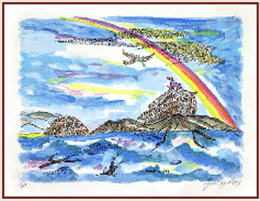Microcalligraphy: Leon Azoulay , Moshe Dadon & Moshe Yair
History of Microcalligraphy
The art of microcalligraphy, creating images out of texts so small that they can barely be seen, is not new. It can be traced back almost 1000 years to the Middle East, where the art form flourished. Each work was painstakingly created over years of intricate labor, as artists illustrated religious texts by using those texts in the painting.
Various artists created beautiful paintings throughout the centuries, but Shalom Moskowitz, a Tzfat-born laborer, popularized the art after he began to explore its possibilities in the years following the 1948 War of Independence. As the Tzfat Artists Colony began to develop in the 1950s, Shalom of Safed, as he became to be known, created vibrant and colorful images of biblical scenes whose "filler" was the actual biblical texts of the Biblical accounts of that particular scene.
Shalom died in 1980, but due to the arrival of other artists who wanted to continue the craft, Tzfat is known today as the center of the art of microcalligraphy.
Three of artists Safed's artists who specialize in Microcalligraphy have galleries in the Old City, and exhibit their microcalligraphy together with other art forms.
Microcalligraphy Today in Tzfat
Moshe Dadon, originally from Morocco, learned microcalligraphy as a boy when local rabbinical leaders, following an anti-Jewish riot, began searching for ways to create tiny Hebrew ritual items, such as a Torah scroll, which could be transported through the city without attracting the attention of people who sought to destroy them. At age eight, Moshe was taught the profession of "sofor-stam", that is, of someone who writes Jewish religious texts on parchment for ritual use. After his immigration to Israel and years working on the local police force, he began to consider returning to this craft, albeit with an artistic angle. He researched the idea of microcalligraphy and began to create Jewish scenes (such as Fiddler on the Roof) together with Biblical scenes (the Book of Ruth, the Book of Psalms, and many others).
Moshe Yair grew up in Tzfat, in a family which traces seven generations in the city. As a child, he was fascinated by his grandmother, who used to write the Book of Psalms in tiny letters, and as a hobby years later, he started to create works of microcalligraphy. His "hobby" drew a lot of interest and attention, and several years ago, he decided to do the microcalligraphy, together with other painting, professionally, and opened a gallery in Tzfat's Old City. Yair expresses the emotion of the Biblical books in his works, among which are the Song of Songs, Lamentations, and Ecclesasties. His Haggadah (Passover guide) painting of the Jews crossing the Red Sea is a particular favorite.
Leon Azoulay grew up in Tzfat after immigrating with his family from Morocco. Living in a city so rich in religious history, Leon couldn't help but be attracted to Jewish heritage, in particular, the Bible. Leon studied fine art and graphics in college, and after finishing his studies, began to search for ways to fuse his two passions, Judaism and art. He found satisfaction in the art of microcalligraphy, which allowed him to create colorful and exciting pictures out of Jewish and Biblical texts. Although his gallery exhibits other forms of his art, it is his microcalligraphy which remains a favorite among visitors, especially his renditions of the Book of Esther and the Story of Exodus, which include, respectively, the entire text of those biblical books.
Leon Azoulay, Moshe Yair and Moshe Dadon work and exhibit in the Old City of Tzfat.

